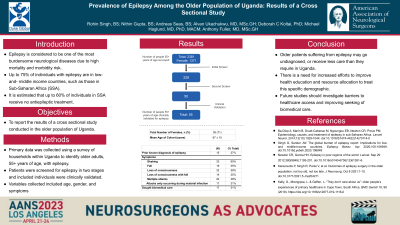Prevalence of Epilepsy Among the Older Population of Uganda: Results of Cross Sectional Study
Friday, April 21, 2023


Nithin Gupta, BS (he/him/his)
Medical Student
Campbell University School of Osteopathic Medicine
Cary, North Carolina, United States
ePoster Presenter(s)
Introduction: A majority of individuals with epilepsy reside in low- and middle-income countries (LMICs), and up to 75% of them do not receive adequate treatment. Sub-Saharan African (SSA) is home to multiple LMICs and although studies have sought to understand the epidemiological and demographic characteristics of epilepsy in this region, none have reported on Uganda specifically. This study seeks to report data from a cross sectional study on epilepsy in older patients in Uganda.
Methods: Primary data was collected using a survey of households within Uganda to identify older adults, aged 55+, with epilepsy. Variables collected included age, gender, income, education, and symptoms. The patients were screened for epilepsy in three stages, and included individuals were validated clinically.
Results: A total of 2381 people (1371 females) 55 and older were surveyed in Uganda. On initial screening 229 patients were deemed positive for epilepsy, of which 50 were positive on the second pass, and 50 remained positive on the third pass. After clinical validation, 55 patients (39 females) were confirmed positive for epilepsy, of which 15 had a known epilepsy diagnosis prior to this study. The mean age of the cohort was 67 +/- 10 years. The symptoms reported in the clinically validated group included shaking in 33 patients, fall in 19, loss of consciousness in 32, loss of consciousness with fall in 14, and multiple attacks in 20. Epilepsy attacks occurring only during malarial infection were reported in 17 individuals. Biomedical care was reported as being sought in 17 patients.
Conclusion : Older patients suffering from epilepsy may go undiagnosed, or receive less care than they need in Uganda. There is a need for increased efforts to improve health education and resource allocation to treat this specific demographic.
Methods: Primary data was collected using a survey of households within Uganda to identify older adults, aged 55+, with epilepsy. Variables collected included age, gender, income, education, and symptoms. The patients were screened for epilepsy in three stages, and included individuals were validated clinically.
Results: A total of 2381 people (1371 females) 55 and older were surveyed in Uganda. On initial screening 229 patients were deemed positive for epilepsy, of which 50 were positive on the second pass, and 50 remained positive on the third pass. After clinical validation, 55 patients (39 females) were confirmed positive for epilepsy, of which 15 had a known epilepsy diagnosis prior to this study. The mean age of the cohort was 67 +/- 10 years. The symptoms reported in the clinically validated group included shaking in 33 patients, fall in 19, loss of consciousness in 32, loss of consciousness with fall in 14, and multiple attacks in 20. Epilepsy attacks occurring only during malarial infection were reported in 17 individuals. Biomedical care was reported as being sought in 17 patients.
Conclusion : Older patients suffering from epilepsy may go undiagnosed, or receive less care than they need in Uganda. There is a need for increased efforts to improve health education and resource allocation to treat this specific demographic.
